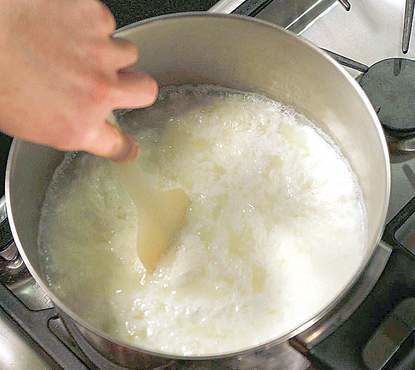Ricotta: a big payoff for such a small effort
Published 5:00 am Tuesday, October 12, 2010

- Making homemade ricotta is a simple process that requires few ingredients and tastes better than what can be bought in stores. When curds start to form, they are spooned out and strained.
When it comes to most things around the house, I’m about the most unhandy guy you’ve ever seen. I can’t hang a picture straight. But when it comes to cooking, I go a little do-it-yourself crazy. The last couple of weeks I’ve been making my own ricotta. Before you dismiss this as just another wacky fad, trust me — you’ve got to give it a try.
It doesn’t require any special equipment, and you can find all of the ingredients at your neighborhood grocery. And the results are so much better than almost any commercial ricotta you can buy that you won’t believe it’s the same stuff. This is ricotta you can — and maybe should — eat by itself.
Here’s all you have to do to make it: Warm a mixture of whole milk and buttermilk over medium heat until it reaches about 185 degrees (you’ll see a ring of bubbles appear around the inside of the pan). Remove the pan from the heat and stir in vinegar (regular old distilled white … the stuff you probably now use for washing windows). Let it stand about 5 minutes until curds form, then gently lift them off with a slotted spoon and drain in a strainer.
That’s it, fresh cheese that takes less than 45 minutes to make. What could be more simple? And it’s kind of wonderful the way it comes together, that everyday sort of kitchen magic that makes cooking something new so much fun.
But how does it taste? Honestly, I was a little skeptical at first. I mean, outside of some really great stuff I’ve had in Italy, I’d always thought ricotta was meant to be kind of bland, so how much better can bland be?
Short answer: Lots. Honestly, this ricotta is so good it can be used as a starring ingredient, not just as the paste that holds together lasagna. The flavor is delicate with a wonderfully milky combination of sweet and tang.
After playing with it for a while (I’ve had lots of ricotta in my refrigerator the last month), I’d say that the more restrained the combination, the better with this stuff. One of my favorite dishes was a lightly herbed mixture used to stuff roasted and peeled red and yellow bell peppers.
Or, based on how amazingly good fresh ricotta is with honey, try making gelato with ricotta, honey and a little orange liqueur. You’ll need to add a little milk and cream to keep the mixture from being chalky, but not so much as to obscure the ricotta flavor.
And those are just a few ideas of many.
Recipe variations
As you might guess, with a process so simple, there is ample room for variation. I spent a couple of weeks trying as many as I could find and after many, many gallons of milk, I think I’ve come up with a version that combines the best of all of them.
The first variable is the milk. You can make ricotta with whole milk or skim milk, and with the addition of whipping cream or buttermilk.
For the acidification, you can use lemon juice, vinegar or buttermilk.
Or you can use a combination. That’s what I wound up with. There is enough acidity in buttermilk that you can use just that and whole milk to make ricotta, but you have to use a lot of buttermilk (2 cups for a half-gallon of milk). Though that buttery flavor is nice, it becomes a little too strong in that concentration.
Regular old distilled white vinegar also works well, but the result is a little bland. Lemon juice works fine, but the acidity will vary depending on the season and so it’s a little unreliable. So I compromised, using 1 cup of buttermilk and 2 1/2 tablespoons of vinegar.
Temperature is another variable. After cooking ricottas to 165, 175, 180, 185 and 190 degrees, I found that the higher the temperature, the greater the amount of cheese you’re able to pull from the whey. On the other hand, after the temperature gets to about 190, the milk solids that stick to the bottom of the pan begin to caramelize and scorch, making them so sticky it takes a lot of scrubbing to clean the pot.
In my laziness, I decided to settle for a smidgen less cheese in exchange for much easier clean-up. At 185 degrees, 10 cups of milk makes about 2 cups — or 1 pound — of cheese. That’s plenty.
Finally, how long you let the cheese stand in the strainer will affect the final texture. The longer it goes, the drier and firmer the curds will be. For me, the sweet spot came after about 5 minutes.
At this point, you may well be tempted to eat the ricotta straight out of the strainer, and indeed, there is something luxurious about eating spoonfuls of the warm curds, sprinkled with a little salt and pepper.
ROASTED PEPPERS STUFFED WITH HOMEMADE RICOTTA
Makes 4 to 6 servings.
4 red or yellow bell peppers, preferably a combination
1 C homemade ricotta
2 TBS capers, chopped
1 TBS olive oil, plus more for finishing
Pinch crushed red pepper
Salt and freshly ground black pepper to taste
1 TBS minced chives
Heat the oven to 400 degrees. Line a jellyroll pan with aluminum foil and place the whole peppers on top. Roast, turning occasionally, until the peppers are shrunken and shriveled, about 20 minutes. Set aside to cool.
While the peppers are roasting, roughly stir together in a small bowl the ricotta, capers, olive oil, red pepper, salt and freshly ground black pepper and chives. Taste and add more salt if necessary.
After the peppers have cooled, peel away the tough skins and discard. Remove the stems and use your fingers to rub off any seeds that stick.
Divide the peppers into lengthwise strips about 2 inches wide; usually this will mean in quarters. Place a scant tablespoon of ricotta filling at one end of the pepper and roll it up end-to-end, pressing gently to keep everything together. Place each completed roll on a platter (it’s nice to alternate red and yellow pieces).
When all of the pepper pieces have been used, lightly drizzle the completed rolls with a little very good olive oil and sprinkle lightly with coarse salt before serving.
Nutrition information for each of 6 servings: 117 calories; 6 grams protein; 6 grams carbohydrates; 1 gram fiber; 8 grams fat; 3 grams saturated fat; 16 mg cholesterol; 3 grams sugar; 196 mg sodium.
HOMEMADE RICOTTA
Makes about 1 pound, or 2 cups.
Note: This recipe requires the use of a thermometer.
9 C whole milk
1 C buttermilk
1 tsp salt
2 1/2 TBS distilled vinegar
Heat the milk and buttermilk in a heavy-bottomed pot over medium heat to a temperature of about 185 degrees. Stir in the salt and vinegar and remove from the heat. Let stand until curds have formed, 5 to 10 minutes. Pull the curds gently to the side
Line a strainer with cheesecloth and set it over a bowl. Using a perforated skimmer, gently lift the mass of curds out of the pot and into the cheesecloth-lined strainer. Repeat until no more curds remain. Discard the remaining whey.
Drain the curds for 5 minutes, then transfer to a covered container to store in the refrigerator until ready to use. The ricotta is best used the same day, but will still be good for 2 to 3 days.
Nutrition information for each 1 ⁄ 4 C serving: 110 calories; 8 grams protein; 2 grams carbohydrates; 0 fiber; 8 grams fat; 5 grams saturated fat; 24 mg cholesterol; 2 grams sugar; 163 mg sodium.
RICOTTA-HONEY GELATO WITH ORANGE
Makes 8 servings (1 quart of gelato).
This is terrific served with lightly sweetened fresh berries or other fruit.
2 C homemade ricotta
1 C whipping cream
1 C whole milk
1⁄3 C sugar
1 TBS orange liqueur, such as Grand Marnier
2⁄3 C honey
Puree the ricotta, whipping cream, milk, sugar, liqueur and honey in a food processor until quite smooth. Taste and add more honey or liqueur if necessary; the flavor should be quite pronounced as it will become muted after freezing.
Pass the mixture through a fine mesh strainer to remove any clumps, and then freeze in an ice cream maker according to manufacturer’s instructions. The texture will be slightly grainy. For the best flavor, the gelato should be eaten the same day.
Nutrition information per serving: 356 calories; 9 grams protein; 37 grams carbohydrates; 0 fiber; 20 grams fat; 12 grams saturated fat; 68 mg cholesterol; 34 grams sugar; 189 mg sodium.






